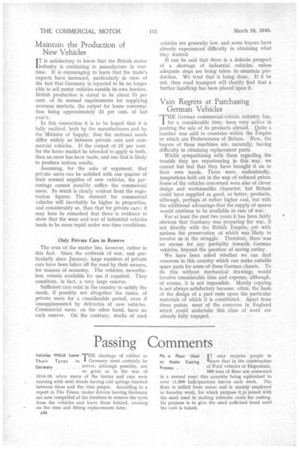Passing Comments
Page 26

Page 27

If you've noticed an error in this article please click here to report it so we can fix it.
Vehicles Which Leave THE shortage of rubber in Their Tyres In Germany must certainly be
Germany severe, although possibly, not
so great as in the war of 1914-18, when many of the lorries and cars were running with steel treads having coil springs inserted between these and the rims proper. According to a report in The Times, motor drivers leaving Germany are now compelled at the frontiers to remove the tyres from the vehicles and leave them behind, crossing on the rims and fitting replacements later.
a24
I T may surprise people to learn that in the construction of Ford vehicles at Dagenham, 500 tons of flour are consumed in a normal year; this quantity being equivalent to over 11,000 half-quartern loaves each week. The flour is milled from maize and is mainly employed in foundry work, for which purpose it js mixed with the sand used in making intricate cores for casting. Its purpose is to give the sand sufficient bond until the core is baked. Ma Flour Used to Assist Casting
Process
German Policemen A T some places in Germany "Lit Up" by Mercury I–Imercury-vapour lamps are Lamps employed to floodlight point -duty policemen during the blackout. These lamps send out invisible rays, but the police become "lit up" by the rays acting on a radio-active material on their uniforms.
Fire Risks Small Di ECALLING the days of With Prod ucer-gas "steam, some insurance corn Vehicles panies, it seems, are associating producer-gas vehicles with the emission of sparks and hot cinders, and are contemplating the calculation of risks accordingly. Actually, the solid-fuel machine of to-day should be safer than the petrol vehicle, because it does not have on board many gallons of highly inflammable liquid. No cinders fall from it as it travels along the road and no sparks are emitted into the air. The probability of an explosion or blow-back is very remote. If inflammable gas does escape, it is usually via a tall stack pipe. The only time hot fuel or clinker is withdrawn is when cleaning out the firebox immediately after a journey. Most drivers, naturally, prefer to postpone carrying out this operation until after the plant has cooled down.
Why Not Better A N interesting suggestion Lights Dimmed at 4Thput forward by Major Warning ? R. A. B. Smith at the C.M.U.A. luncheon last week was that vehicles should be allowed to have better lighting, capable of being quickly dimmed. A suitable warning signal would be mauve lights on the traffic signals, assisted by warnings from road scouts of the motoring organizations.




































































